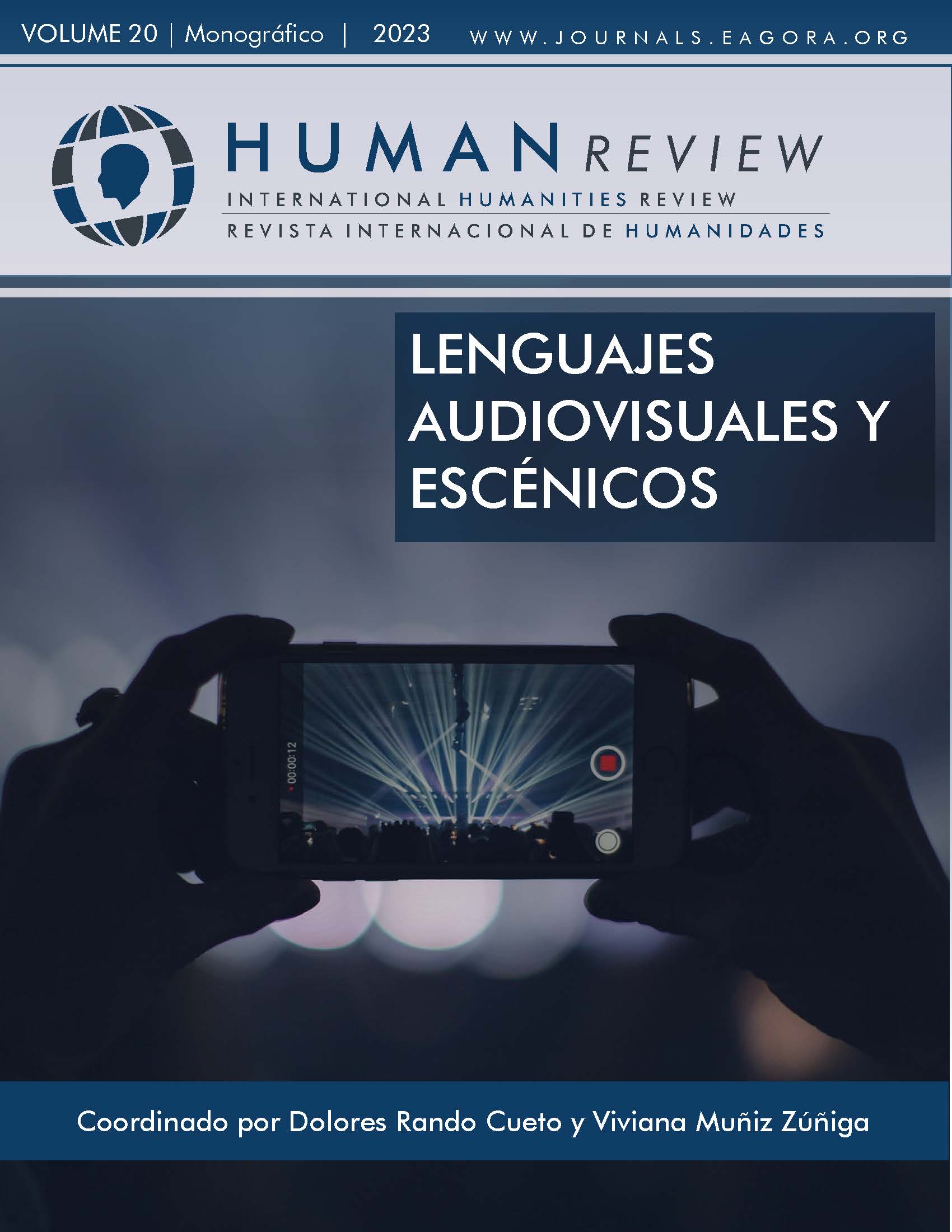The language of the camera in the The Favourite´s audiodescription
DOI:
https://doi.org/10.37467/revhuman.v20.4939Keywords:
Audiodescription, Audiovisual translation, Artistic accessibility, Film analysis, Yorgos Lanthimos, The FavouriteAbstract
The present study analyzes when and how ONCE describes the language of the camera in The Favourite (Yorgos Lanthimos, 2018) to identify excesses and defects due to sound redundancy that can compromise the understanding of the message and the artistic experience in the blind. To this end, the visual codes, the context of the production, the sound and the semantic and linguistic strategies used in its description have been analyzed. The results show that the text ignores formal aspects related to the transcription of reality, composition and movement that affect the interpretation and aesthetic perception of the film.
References
AENOR (2005). NORMA UNE 153020: Audiodescripción para personas con discapacidad visual. Requisitos para la audiodescripción y elaboración de audioguías. Madrid: AENOR.
Blanco F. y Rubio M. E. (1993). Percepción sin visión. En A. Rosa y E. Ochaíta (Eds.), Psicología de la ceguera (pp. 51-110). Alianza: Madrid. https://doi.org/10.1080/02103702.1988.10822194
Bordwell, D. (1996). La narración en el cine de ficción. Paidós.
Bordwell, D. y Thompson, K. (2010). El arte cinematográfico. Madrid: Paidós comunicación.
Bourne, J. (2007). El impacto de las directrices ITC en el estilo de cuatro guiones AD en inglés. En C. Jiménez (Ed.), Traducción y accesibilidad. Subtitulación para sordos y audiodescripción para ciegos: nuevas modalidades de Traducción Audiovisual (pp. 179-198). Peter Lang.
Casetti, F. y Di Chio F. (1991). Cómo analizar un film. Paidós.
Chapado Sánchez, M. (2010). La audiodescriptibilidad del film: una nueva perspectiva de análisis fílmico. Frame, 6, 159-195. https://bit.ly/3DJzCob
Chion, M. (1993). La audiovisión. Introducción a un análisis conjunto de la imagen y el sonido.Paidós.
Di Mattia, J. (2019). Bedroom Games: Sex and power in The Favourite. Screen Education. Melbourne [On-line] 95, 8-15 https://bit.ly/3fiMmsJ
Fix y Morgner (2005). Narration im Hörfilm-Theorie und Analyse. En U. Fix (Ed.), Hörfilm: Bildkompensation durch Sprache. Linguistisch-filmisch-semiotische Untersunchungen zur Leistung der Audiodeskription in Hörfilmen am Beispiel des Films “Laura, mein Engel” aus der “Tatort”-Reihe (pp. 117-153). Erich Schmidt Verlag.
Fryer, L. (2010). Audio Description as Audio Drama – a Practitioner´s Point of View. Perspectives: Studies in Translatology, 18 (3), 205-213. https://doi.org/10.1080/0907676X.2010.485681
Gonant, F. y Morisset, L. (2008). La charte de láudiodescription. Ministère des Affaires Sociales et de la Santé. https://bit.ly/3FB2tN0
Gómez Tarín, F. J. (2010). El análisis de textos audiovisuales. Significado y sentido. Shangrilá Ediciones.
Grobar, M. (2018, 6 de noviembre). The Favourite DP Robbie Ryan Fisheye Lenses y Fluid, Roving Camera To Yorgos Lanthimos’ Madcap Period Piece. Deadline. https://bit.ly/3NpOJGL
Igareda, P. (2012). Lyrics Against Images: Music and Audio Description. MonTi, Monografías de Traducción e Interpretación, 4, 233-254. http://dx.doi.org/10.6035/MonTI.2012.4.10
Lanthimos, Y. (Director). 2018. The Favourite [película]. Element Pictures, Scarlet Films, Film4 Productions, Waypoint Entertainment.
Lanthimos, Y. (Director). 2017. The Killing of a Sacred Deer [película]. Element Pictures, A24, Film4.
Lanthimos, Y. (Director). 2011. Alps [película]. Haos Films.
Lasagna, R. y Pallavidino, B. (2019). Anestesia di solitudini: Il cinema di Yorgos Lanthimos. Sesto San Giovanni: Mimesis Edizione.
Maszerowska, A. (2013). Language without words : Light and contrast in audio description. The Journal of Specialised Translation, 20, 165-180. https://bit.ly/3NLqdQv
Peña Sarrionandia, M. (2021). Retrato del individuo posmoderno en el cine de Yorgos Lanthimos. Ámbitos. Revista Internacional de Comunicación, 55, 163-180. https://doi.org/10.12795/Ambitos.2022.i55.10
Peña Sarrionandia, M. (2022). Giza harremanak, botere harremanak: Yorgos Lanthimos zinema [Tesis doctoral, univeresidad del País Vasco]. https://bit.ly/3h3Ggws
Perego, E. (2014). Film language and tools. En A. Maszerowska, A. Matamala, P. Orero (Eds.), Audio description: New perspectives illustrated (pp. 81-102). Amsterdam: Benjamins. http://dx.doi.org/10.1075/btl.112
Perego, E. (2015). Film Techniques. En A. Remael, N. Reviers, G. Vercauteren (Eds), Pictures painted in words: ADLAB Audio Description. EUT: Trieste. http://hdl.handle.net/10077/11838
Pérez Payá, M. (2010). Recortes de cine audiodescrito: el lenguaje cinematográfico en Taggetti Imagen y su reflejo en la audiodescripción. En C. Jiménez Hurtado, A. Rodríguez Domínguez, y C. Seibel (Eds.), Un corpus de cine. Teoría y práctica de la audiodescripción (pp. 111-179). Tragacanto.
Pérez Payá, M. (2015). Guión cinematográfico y guión audiodescriptivo: un viaje de ida y vuelta. [Tesis doctoral, Universidad de Granada]. https://bit.ly/3DqLZ7f
Remael, A. (2012). For the use of sound. Film sound analysis for audio description: some key issues. MonTi, Monografías de Traducción e Interpretación, 4, 255-276. http://dx.doi.org/10.6035/MonTI.2012.4.11
Remael, A. y Vercauteren, G (2010). The translation of recorded audio description form English into Dutch. Perspectives, 18(3), 155-171. https://doi.org/10.1080/0907676X.2010.485684
Rodríguez Bravo, A. (1998). La dimensión sonora del lenguaje audiovisual. Paidós Ibérica: Barcelona.
Smith, S. (2018). Yorgos Lanthimos´s Venice Film Festival crowd pleaser The Favourite filmed almost exclusively at Hatfield House, Hertfordshire. The Location Guide. https://bit.ly/3DQ8TGA
Szarkowska, A. y Orero, P. (2014). The importance of sound for audio description. En A. Maszerowska, A. Matamala y P. Orero (Eds.), Audio Description. New perspectives illustrated (pp. 121-139). (Benjamins Translation Library; Vol. 112). https://doi.org/10.1075/btl.112.08sza
Vázquez, A. (2019). Audiodescripción: norma y experiencia. Granada: Ediciones Tragacanto.
Downloads
Published
How to Cite
Issue
Section
License
Those authors who publish in this journal accept the following terms:
- Authors will keep the moral right of the work and they will transfer the commercial rights.
- After 1 year from publication, the work shall thereafter be open access online on our website, but will retain copyright.
- In the event that the authors wish to assign an Creative Commons (CC) license, they may request it by writing to publishing@eagora.org









